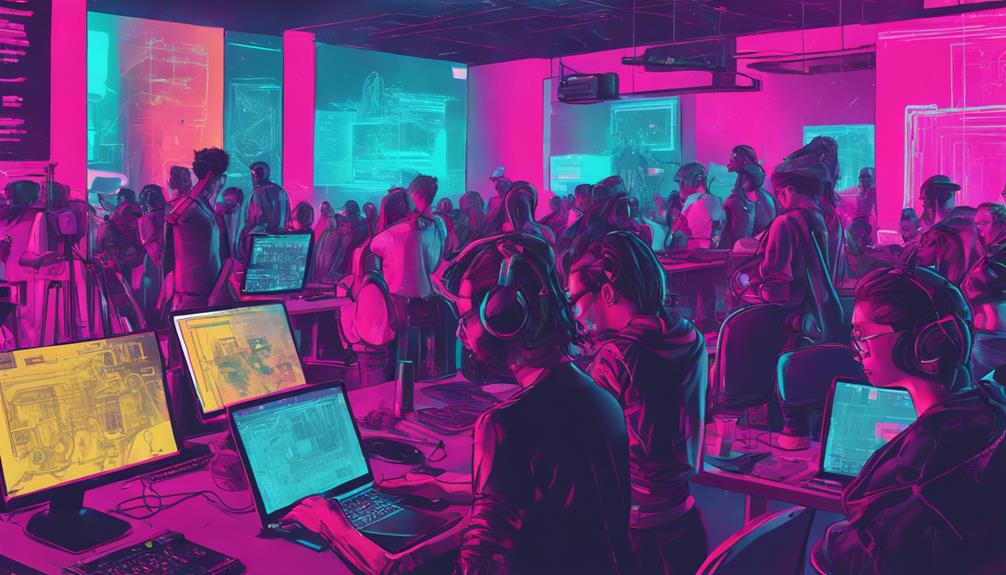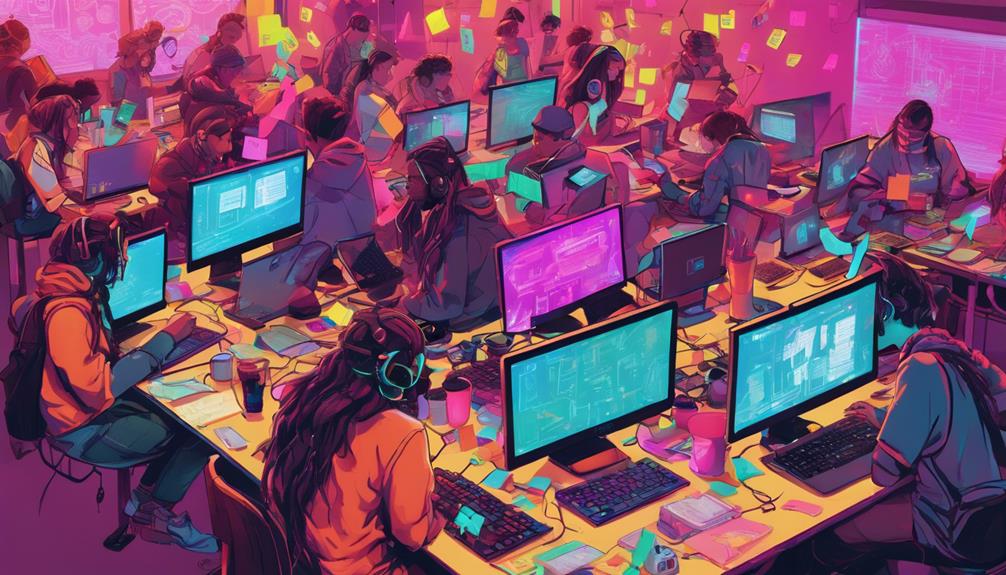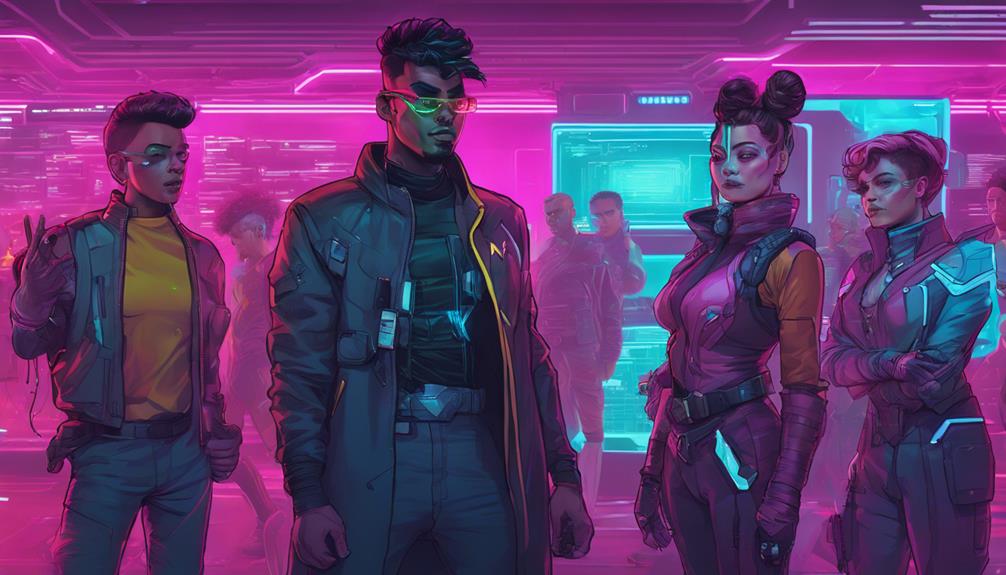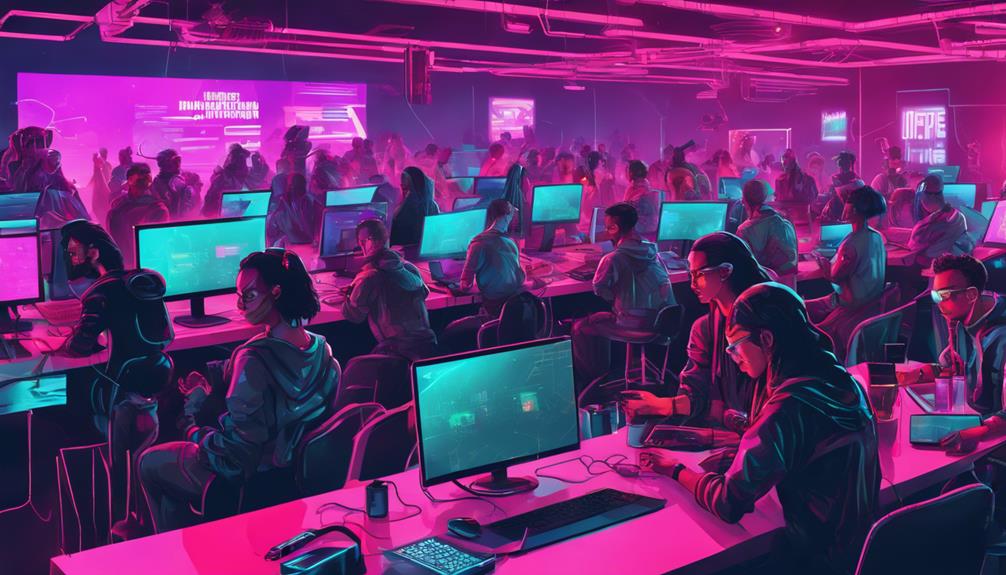Participating in UX hackathons allows us to immerse ourselves in design, where user experience shines in solving real challenges and refining UI/UX skills. We tackle hands-on projects, enhancing problem-solving abilities and teamwork. Tools like Figma and Major League Hacking aid in collaborative design opportunities. Showcase design principles, user testing expertise, and innovation to excel in hackathons. Judges focus on creativity, coherence, and user-centric solutions during evaluations. Engage in networking to build industry connections and open doors to career prospects. Reflect on challenges post-event to improve. To succeed, grasp design principles, streamline processes, and balance seriousness with engaging elements. The future hints at sustainable solutions and community involvement.
Key Takeaways
- Emphasis on user-centric design solutions.
- Integration of innovative UI/UX elements.
- Focus on creating seamless user experiences.
- Design challenges centered around problem-solving.
- Collaboration for cohesive and engaging design projects.
Benefits of Participating
Participating in UX hackathons offers numerous benefits that enhance design skills and problem-solving abilities. These events provide valuable hands-on experience, allowing participants to tackle real-world design challenges in a time-constrained environment.
By working collaboratively with industry professionals and receiving feedback, individuals can refine their design solutions and learn from others in the field. Hackathons also offer a unique opportunity to build a limited portfolio with innovative design projects and case studies, showcasing one's creativity and problem-solving skills.
For junior UX designers, these events serve as a platform to network with potential employers, gain practical experience, and boost confidence in their design projects. Engaging in UX hackathons not only allows individuals to share valuable insights and experiences through written content but also fosters a sense of community within the design industry.
Challenges to Expect
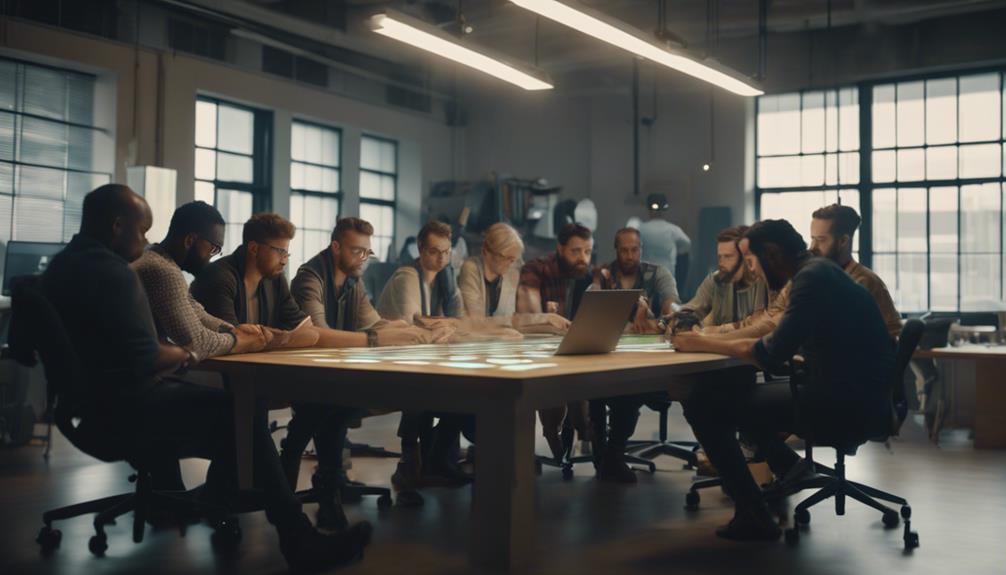
Facing a variety of obstacles, participants in UX hackathons must navigate complex design challenges within a limited timeframe. Teamwork plays an essential role in overcoming these hurdles, as individuals collaborate to merge diverse perspectives and skills. Communication within the team is vital for brainstorming ideas, dividing tasks efficiently, and ensuring a cohesive final product.
During the hackathon, time management becomes a significant challenge, with teams needing to balance creativity and innovation with the pressure of meeting deadlines. Additionally, participants often encounter technical constraints and resource limitations that require quick thinking and adaptability to find solutions.
Another common challenge is aligning design solutions with the given theme or challenge prompt. This demands a deep understanding of user needs, market trends, and the ability to translate research insights into practical design elements.
Despite these difficulties, teamwork fosters a supportive environment where participants can leverage each other's strengths to create impactful and user-centered designs.
Tools and Resources Needed

Mastering the challenges of UX hackathons requires access to specific tools and resources to enhance collaborative design efforts and project success. As a UX designer participating in hackathons, it is essential to have the right resources at your disposal. Designers often rely on tools like Figma for seamless collaborative design and maintaining consistency across UX projects. Platforms such as Major League Hacking and Eventbrite offer excellent opportunities to engage in hackathons and showcase your skills.
To excel in these events, effective team collaboration and communication are key. Utilizing free design systems and kits can jumpstart your design process and provide a solid foundation for your projects. Here is a table outlining some essential tools and resources for UX designers in hackathons:
| Tools/Resources | Description |
|---|---|
| Figma | Collaborative design tool for UX projects |
| Major League Hacking | Platform offering hackathon opportunities |
| Eventbrite | Source of hackathon events and registrations |
| Design Systems | Free resources for consistent design elements |
| Beginner Hackathons | Opportunities for skill enhancement and networking |
Key Skills to Showcase

When participating in UX hackathons, it's vital to showcase essential design principles and effective user testing skills.
By demonstrating a solid understanding of design fundamentals and the ability to conduct user testing efficiently, participants can create impactful and user-centric solutions.
These key skills not only enhance the overall UX design process but also contribute to the success of hackathon projects.
Essential Design Principles
In mastering essential design principles, we showcase key skills that elevate our user experience expertise at a hackathon. These principles encompass usability, accessibility, and user-centered design, forming the foundation for creating intuitive interfaces and engaging experiences.
By demonstrating proficiency in information architecture, visual hierarchy, and interaction design, we enhance the usability and visual appeal of our designs. Additionally, highlighting knowledge of user research, prototyping, and testing methodologies guarantees that our designs aren't only visually pleasing but also functional and user-friendly.
Designing for various platforms, such as web, mobile, and desktop applications, requires a deep understanding of how users interact with different devices. Incorporating these design principles into our projects at a hackathon not only improves the overall user experience but also sets us apart as designers who prioritize creating impactful and user-centric solutions.
Effective User Testing
To demonstrate our proficiency in user testing, we conduct usability tests on design prototypes to gather valuable feedback and insights from our target users. By creating test scenarios, moderating user sessions, and analyzing results, we showcase our ability to improve the user experience.
Identifying usability issues, prioritizing findings, and recommending design solutions based on user feedback are key skills we highlight. Our expertise extends to creating user personas, conducting A/B testing, and implementing iterative design improvements through user testing.
User testing plays an essential role in validating design decisions, enhancing user satisfaction, and optimizing the overall usability of digital products. It's through these practices that we show our commitment to refining and perfecting the user experience, ensuring that our designs meet the needs and expectations of our target audience.
Judging Criteria Explained

Let's explore the detailed breakdown of how judging criteria are explained in UX hackathons. Judges in these events often scrutinize projects based on various factors to determine their effectiveness. Key aspects considered include innovation, user experience, and problem-solving capabilities.
Design coherence, creativity, and alignment with the given challenge are essential elements that judges look for in submissions. Additionally, user-centric design, storytelling, and smooth progressions between screens play a significant role in securing a high score.
To excel in UX hackathons, participants should focus on understanding user needs, incorporating feedback, and creating unique solutions that stand out. Judges evaluate projects based on interface design, usability, innovation, and overall user experience.
Networking Opportunities

Exploring the networking landscape at UX hackathons reveals valuable connections with industry professionals, mentors, and fellow designers. These events offer a platform for participants to engage in workshops, panel discussions, and networking sessions, facilitating the expansion of knowledge and the establishment of relationships with like-minded individuals.
Networking opportunities at UX hackathons not only enable the sharing of ideas and feedback but also provide a valuable learning experience by interacting with seasoned professionals in the field. Collaborating with diverse teams during hackathons fosters a rich exchange of perspectives, leading to innovative design solutions and unique insights.
Furthermore, networking at UX hackathons can open doors to potential job prospects, partnerships, and exposure to a broader design community for participants. The connections made during these events can pave the way for future collaborations and career advancement within the UX design industry. Participants are encouraged to actively engage in networking opportunities to maximize the benefits of attending UX hackathons.
Post-Hackathon Reflections

Engaging in post-hackathon reflections provides valuable insights into the design process and team dynamics. Reflecting on our recent hackathon experience, our team members gathered to discuss key aspects that emerged during the event.
- Analyzing Challenges:
We explored the specific challenges faced during the hackathon, identifying areas where our design process could have been more efficient and effective.
- Highlighting Successes and Failures:
Team members shared their perspectives on what went well and areas that could have been improved. This open discussion allowed us to celebrate successes and acknowledge failures constructively.
- Lessons Learned for Future Improvement:
Through our reflections, we outlined actionable lessons learned from the competition. These insights will guide us in refining our design strategies and team collaboration for future hackathons.
Tips for Success

To succeed in a UX hackathon, it's essential to understand key design principles and foster strong collaboration within your team.
By aligning on the problem and solution early on, you can streamline the app development process effectively.
Utilizing tools like Figma for prototyping and balancing seriousness with engaging design elements will set you on the path to success.
Key Design Principles
Incorporating key design principles is essential for success in Ux hackathons, emphasizing the importance of user feedback and testing to refine design solutions.
When focusing on real-world applications, here are three key design principles to keep in mind:
- Seamless User Experiences: Tell a story through your design, ensuring smooth flow between different elements. This creates a cohesive and engaging experience for users, enhancing the overall usability of your project.
- Innovative Design Elements: Stand out from the competition by incorporating unique and creative design elements. This can help captivate judges and users alike, leaving a lasting impression and setting your project apart.
- User-Centric Design: Prioritize the needs and preferences of your target audience. By aligning your interface design and user experience with what users expect and find intuitive, you increase the chances of creating a successful and impactful project.
Collaboration and Teamwork
Effective collaboration is essential for achieving success in UX hackathons, requiring teams to constantly exchange opinions and ideas to maintain a cohesive visual aesthetic. In these intense design competitions, collaboration is the cornerstone that can make or break a project. Team composition plays a pivotal role in fostering productive teamwork. Balancing skills and interests within a team of 3-4 members is key to ensuring effective collaboration and a shared vision.
During hackathons, time is a precious commodity. This scarcity underscores the importance of streamlined communication and collaboration. Shifting everything to tools like Figma can be a challenge, making effective teamwork even more critical.
Participating in beginner hackathons can provide valuable experience in collaborative design processes, setting the stage for future success in more advanced competitions.
Future of UX Hackathons

Looking ahead, the evolution of UX hackathons showcases a shift towards incorporating diverse themes such as sustainability and education. This trend reflects a growing awareness among participants of the importance of using design for social good and environmental impact.
As UX hackathons continue to evolve, we can expect to see the following developments:
- Increased Focus on Sustainable Solutions: Teams will likely prioritize creating apps that promote eco-friendly behavior and sustainable practices, aligning with the global push for environmental conservation.
- Integration of Educational Elements: Hackathons may incorporate educational aspects into their challenges, encouraging participants to develop apps that enhance learning experiences or address educational gaps in society.
- Broader Community Engagement: The future of UX hackathons may involve more collaboration with diverse communities and stakeholders, fostering inclusive design practices and innovative solutions that cater to a wider range of user needs.
Frequently Asked Questions
What Are the 4 Phases of the UX Project Process?
Familiar with the 4 phases of the UX project process: discovery, design, development, delivery. Discovery involves research, interviews, persona creation. Design focuses on wireframing, prototyping, visual design. Development includes coding, testing, refining UI. Delivery involves launch, feedback, iteration for improvement.
What Are the Steps in the UX User Experience Design Lifecycle?
Understanding user needs and behaviors through research, we then design wireframes and visual interfaces. Prototyping interactive models for user testing, we refine based on feedback. Ultimately, we implement the final design for the best user experience.
What Are the 6 Stages of the UX Design Process?
We are familiar with the 6 stages of the UX design process. Research, ideation, wireframing, prototyping, testing, and implementation are all essential steps. Each phase contributes to creating user-centered designs that prioritize user needs and behaviors.
What Are the 4 Parts of the UX Design Lifecycle?
The UX design lifecycle consists of Research, Design, Testing, and Implementation stages. We gather user insights, create wireframes, conduct usability testing, and bring final designs to life. Our focus is on user-centered design principles for outstanding experiences.
Conclusion
To sum up, UX hackathons offer a unique opportunity to showcase design skills, network with industry professionals, and push creative boundaries.
By participating in these events, designers can challenge themselves, gain valuable feedback, and contribute to the advancement of user experience.
While the challenges may be intimidating, the rewards are well worth the effort.
So, whether you're a seasoned designer or just starting out, consider joining a UX hackathon and see where your creativity can take you.
